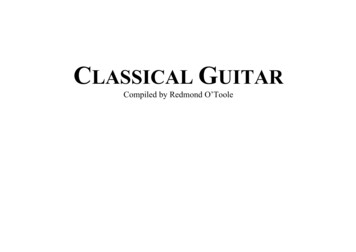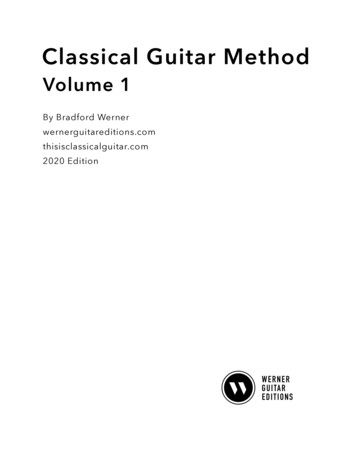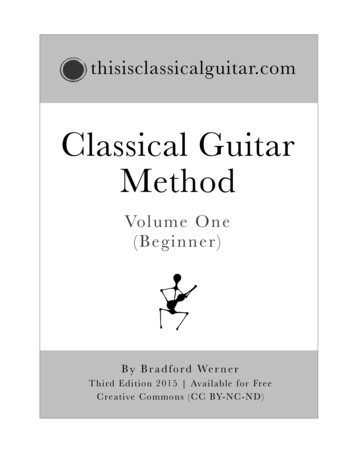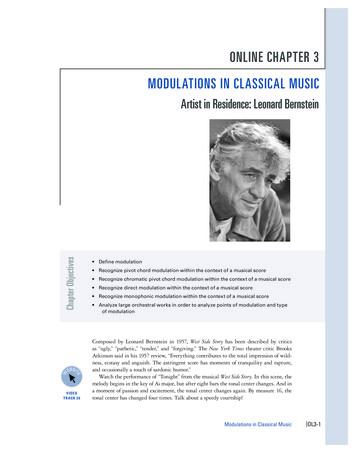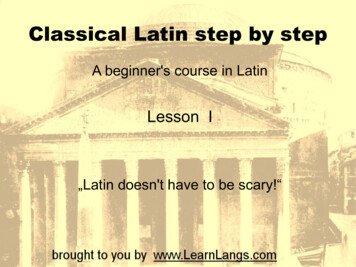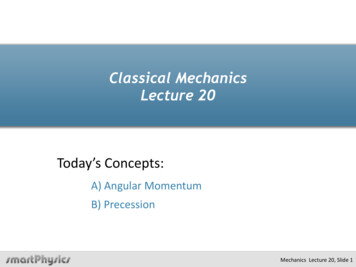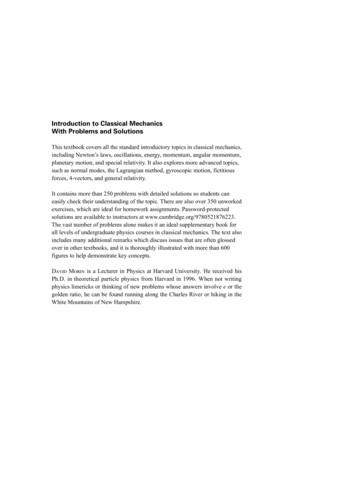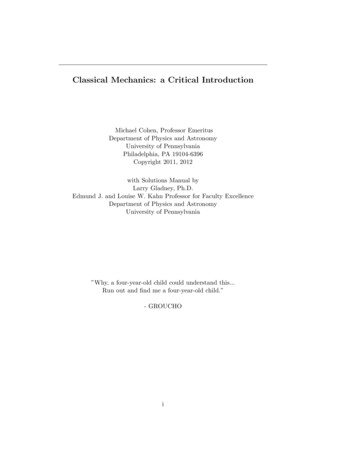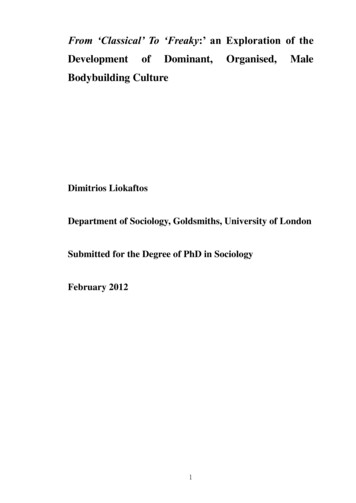
Transcription
From ‘Classical’ To ‘Freaky:’ an Exploration of g CultureDimitrios LiokaftosDepartment of Sociology, Goldsmiths, University of LondonSubmitted for the Degree of PhD in SociologyFebruary 20121
Declaration:The work presented in this thesis is my own.Dimitrios LiokaftosSigned,2
AbstractThrough a combination of historical and empirical research, the present thesisexplores the development of dominant, organized bodybuilding culture across threeperiods: early (1880s-1930s), middle (1940s-1970s), and late (1980s-present). Thisperiodization reflects the different paradigms in bodybuilding that the researchidentifies and examines at the level of body aesthetic, model of embodied practice,aesthetic of representation, formal spectacle, and prevalent meanings regarding the'nature' of bodybuilding. Employing organized bodybuilding displays as the axis forthe discussion, the project traces the gradual shift from an early bodybuilding model,represented in the ideal of the 'classical,' 'perfect' body, to a late-modern modelcelebrating the 'freaky,' 'monstrous' body. This development is shown to haveentailed changes in notions of the 'good' body, moving from a 'restorative' model of'all-around' development, health, and moderation whose horizon was a return to anunsurpassable standard of 'normality,' to a technologically-enhanced, performancedriven one where 'perfection' assumes the form of an open-ended project towards the'impossible.' Central in this process is a shift in male identities, as the appearance ofthe body turns not only into a legitimate priority for bodybuilding practitioners butalso into an instance of sport performance in bodybuilding competition. Equallycentral, and related to the above, is a shift from a model of amateur competition andnon-instrumental practice to one of professional competition and extreme measuresin search of the winning edge. Explored in its different facets, the currently dominantparadigm, whose origins are traced back to a late-1960s USA context, is shown tohave prevailed through aligning itself with a larger ideology of self-actualization andperformance as well as a corporate modus operandi. Despite exhibiting increasinglyinsular tendencies at a national level in the last 20 years, it is shown to reproduceitself and even expand through its global reach.3
Table of ContentsPreface8-9Chapter 110-22Introduction: Genealogy and Scope of the ProjectChapter 223-49Literature Review: Works on Bodybuilding and Beyondthat Have Helped Shape the ProjectChapter 350-70Researching Bodybuilding Cultures: Methods, Processes, and SourcesChapter 471-103Building 'Perfect' Bodies: The Restorative Model of the Early Period (1880s-1930s)Chapter 5104-133From 'Ideal Manhood' to 'Muscle For Muscle's Sake:' Shift of Paradigm in theMiddle Period (1940s-1970s)Chapter 6134-153'Breaking Boundaries:' 'Freaky' Bodies and the Paradigm of Elite PerformanceChapter 7154-178Machine, Animal, Hardcore: 'Freak' as Dominant Approach to the EmbodiedPractice, Aesthetic of Representation, and Group IdentityChapter 8179-206A 'Monstrous' Practice for Producing the 'Monstrous' Body: Drug Use forBodybuilding PurposesChapter 9207-232'Extreme Sport' and Corporate Entertainment: The 'Freaky' Body as CommodifiedSpectacleFurther Thoughts and Projects233-240Bibliography241-2534
List of ImagesImage 1: Arnold Schwarzenegger in his bodybuilding 'prime' in the mid-1970sImage 2: Photo illustration from the book Life is Movement, Or the PhysicalReconstruction and Regeneration of the People (1919)Image 3: Photo illustration from the book How to Pose (1914)Image 4: Publicity material for Eugene Sandow's American vaudeville shows (1894)Image 5: Publicity card of Melvin Burkhart (unidentified year)Image 6: Illustration from the book Muscle Control or Body Development by WillPower (1911)Image 7: Strength & Health magazine cover, February 1958Image 8: The Young Physique magazine cover, Vol.5, No.2, 1963Image 9: Muscle Builder/Power magazine cover, August 1970Image 10: Publicity poster for the 45th anniversary of the Mr. Olympia contestImage 11: Arnold Schwarzenegger and Ronnie Coleman on the 2004 Mr. OlympiastageImage 12: Dorian Yates training photo at the 'Mecca of Bodybuilding,' Gold's Gym,Venice, California in the early-1990sImage 13: Promotional material for the Animal line of 'hardcore' bodybuildingtechnologiesImage 14: Muscle Builder/Power magazine cover, March 19685
Image 15: Dorian Yates months before his 1993 Mr. Olympia victoryImage 16: Digital billboard of Mandalay Bay Hotel and Casino hosting the 2004 Mr.Olympia (field trip photo)Image 17: Pictorial from All Natural Muscular Development, August 1998Image 18: Muscular Development magazine cover, September 20016
AcknowledgmentsI am thankful to my supervisor Vic Seidler for his faith, insights, 'old school' modelof practicing thinking and writing, and for being right there with me in the finalrounds. To my extended family and friends for their ongoing support, and mostnotably to Val for making me laugh at myself. To the various other PhD fellows whoappear, disappear, and reappear. To the members of Goldsmiths Sociology whoseacademic work, presence, and integrity are inspiring. To the members of support staffwho have always been extremely generous with me.Sincere thanks for their generosity go to all who participated in this research,especially to David Chapman and the directors of the H.J. Lutcher Stark Center forPhysical Culture and Sports (University of Texas at Austin) for granting me access toa wealth of archival material.This project is dedicated to my parents who've waited for so long.7
PrefaceI have always found bodybuilding interesting. I got introduced to it as a boy,watching Arnold Schwarzenegger's movies on mid-1980s Greek TV and in a Greekbodybuilding magazine called Athlete that often cut and pasted articles and photosfrom American publications without necessarily acknowledging sources. I sweatedwith a chest expander at home for quite some time till I was old enough to join a gymfor the first time in my home-town, Sparta.My practice became more intense, systematic, and sophisticated when Imoved to Athens for my undergraduate studies in English Literature and Culture. Idevoured the international muscle magazines along with 6 meals a day and someprotein powders imported from the USA and Germany for a couple of years. I alsoattended my first bodybuilding contest, the 1996 Mr. Hellas, and cheered for acompetitor from Sparta, the same guy who owned the gym I had first joined at 15.Over a relatively short period of time, I saw drastic changes in my body and in myperception of myself and the world. For better or worse, I was not able to tell thedifference between, on the one hand, the pain that results from productive trainingand which signals growth and, on the other hand, the pain that comes fromcounterproductive training and which signals injury. Eventually, though verygradually, I stopped bodybuilding. I have taken it up again recently, even if in a verydifferent way that I assembled partly through doing the present research.Thinking and writing this thesis has involved, among other things, thecreative tasks of making unfamiliar and distant what had for years been familiar anddear, as well as the opposite: on the one hand, I had to examine 'objectively'bodybuilding culture and its traditions of looking at and experiencing one's body,those of others, and life more generally, all of which had for some time become'second nature' to me. On the other hand, I had to manage this in the language andlogic of sociological research, a new territory with its own discipline that I gotintroduced to when I started my PhD.The development of the above I try to present schematically in theintroduction that follows, and which I frame in terms of a genealogy of the project. Ihave chosen to present this not by smoothing out but highlighting a lot of thefluctuations in my thinking and writing. This attempt to do justice to my researchprocess has involved going through what I produced in the past, and appreciating8
how the reformulation of my conceptual framework and research questions has beenin itself a significant part of doing the present work. The introduction concludes withthe thesis chapter break-down.Image 1 Arnold Schwarzenegger in his bodybuilding 'prime' in the mid-1970s1The image above is the poster of Arnold that I cut out from a Greek bodybuildingmagazine, hanged on my wall, and exercised under at the age of 12. When I grew upI found it constantly reproduced in print and online bodybuilding magazines, andconsidered by many in dominant bodybuilding culture as one of his most iconicimages.1Image source: .html; ac. 08.09.2010.9
Chapter 1Introduction: Genealogy and Scope of the ProjectGenealogy and Scope of the ProjectThe initial spark for the project was an empirical observation: bodybuildingand bodybuilders, particularly those of the 'extreme' type, are talked about as 'freaky'or 'monstrous' by both insiders and outsiders to the bodybuilding culture. For manylooking from the 'outside,' the 'freaky' built body is perceived as disgusting,threatening, perverse, and/or grotesque (Lindqvist 2003; Lingis 1994). Commonreactions of revulsion and derision are directed not only towards the specular builtbody but also what is perceived to be a whole subculture of pathology that gives birthto it (Monaghan 2001).2 From the same standpoint, bodybuilding in its form asorganized spectacle gets dismissively labelled as a 'freak show.' At the same time, Iwas equally aware of a fact that not many people outside the bodybuilding cultureknow or can comprehend: bodybuilders themselves habitually use the term 'freak' or'monster' to speak of each other.3 In this case, though, the spirit is one of attributionof respect and admiration not only for what one looks like but also, and equallyimportantly, what they had to do to achieve it. Being recognized as a 'freak' isessentially translated into a distinct and distinguishing status in the world ofbodybuilding.While playing around with the notion of the 'freak' as a marker of radicaldifference, positive or negative depending on one's standpoint, I came across CecileLindsay's (1996) 'Bodybuilding: a Postmodern Freak Show' in the edited collectionFreakery: Cultural Spectacles of the Extraordinary Body, which introduced me tothinking early bodybuilding in relation to the 19th century freak show. My initialresearch hypothesis was formulated as such: 'To what extent can modernbodybuilding be theorized as a continuation of the freak show?' This led me to an2Suggestive of this is the sketching and recognition by medical authorities of disorders that aretypically identified with practitioners of bodybuilding, such as 'muscle dysmorphia' as a particulartype of body dysmorphic disorder (Pope, Phillips, and Olivardia 2000).3When discussing the current bodybuilding culture, I sometimes use 'freak' and 'monster'interchangeably as is the case inside the culture, too.10
investigation of the late-19th/early-20th century freak show as a particular culturalform and, through a naturally occurring comparative attempt, to early bodybuildingexhibitions that first took place in the same period. My parallel researching of thebodybuilding 'freak' of today had made me aware from early on that it stands for aparticular type of body aesthetic and model of practice which cannot be thoughtseparately from the frames from which it arises (namely, elite bodybuildingcompetition) and where it features as a central representation of bodybuilding(namely, the bodybuilding media and industry). In effect, the 'freaky' body hasbecome a dominant representation, what 'outsiders' and 'insiders' alike recognize,even if they appreciate it differently, as bodybuilding. The more I researched themore aware I became -and wanted to address- the meanings and contexts particularto the organized display of the built body. Apart from my personal interest in this, Ialso felt there is space for original contribution in this respect in the literature onbodybuilding. It was in this light that I opted for a crystallization of the subject of mystudy, deciding to focus on competition bodybuilding as formalized spectacle. Thisdecision shaped the targets and methods for my first field trip that was being plannedat this juncture, and which I will discuss in detail in Chapter 3.This was also the time I decided to focus my study on male bodybuilding forseveral reasons. Not only is it something I am personally more interested in, but ithas been less explored in comparison to its female counterpart whose 'freakery' istypically located at its gender-transgressing quality (Aoki 1996). Given an extensivehistorical scope that I was increasingly leaning towards, male bodybuilding presenteditself as the de facto object of study, its history being much longer and in importantways quite distinct from that of female bodybuilding. In some instances the latter hasbeen useful for appreciating certain gendered aspects of its male counterpart thatwould have otherwise been hard to identify. Unless explicitly specified, I use theterm 'bodybuilding' to refer to male bodybuilding throughout the thesis.My exploration of the late-19th/early-20th century freak show andbodybuilding exhibitions, a good deal of which came out of or was further enabledby my first field trip archival research, led me to the conclusion that my initialresearch hypothesis was of an impossible nature as I was trying to compare/contrasttwo essentially 'different' things. Not only were the meanings inscribed in the builtbody and its exhibition drastically different, if not the opposite, to those of the earlyfreak show, but bodybuilding exhibition was, precisely on the basis of the particularmeanings inscribed in it
Image 12: Dorian Yates training photo at the 'Mecca of Bodybuilding,' Gold's Gym, Venice, California in the early-1990s Image 13: Promotional material for the Animal line of 'hardcore' bodybuilding technologies Image 14: Muscle Builder/Power magazine cover, March 1968 . 6 Image 15: Dorian Yates months before his 1993 Mr. Olympia victory Image 16: Digital billboard of Mandalay Bay Hotel and .
